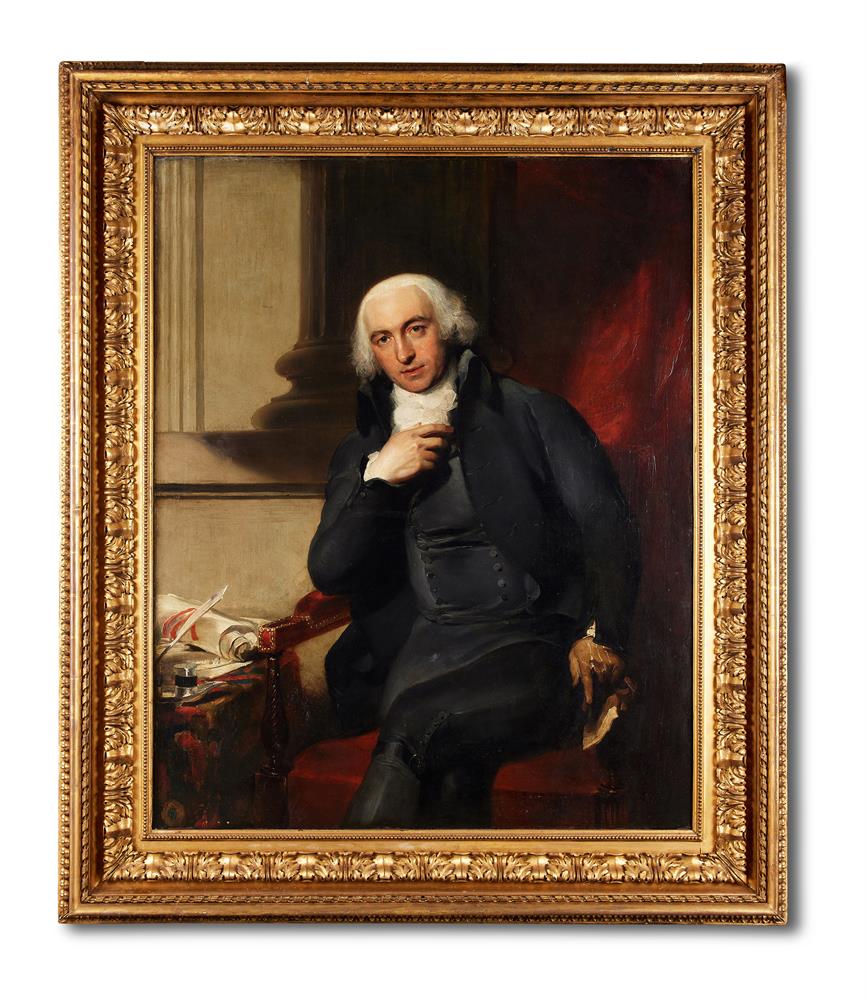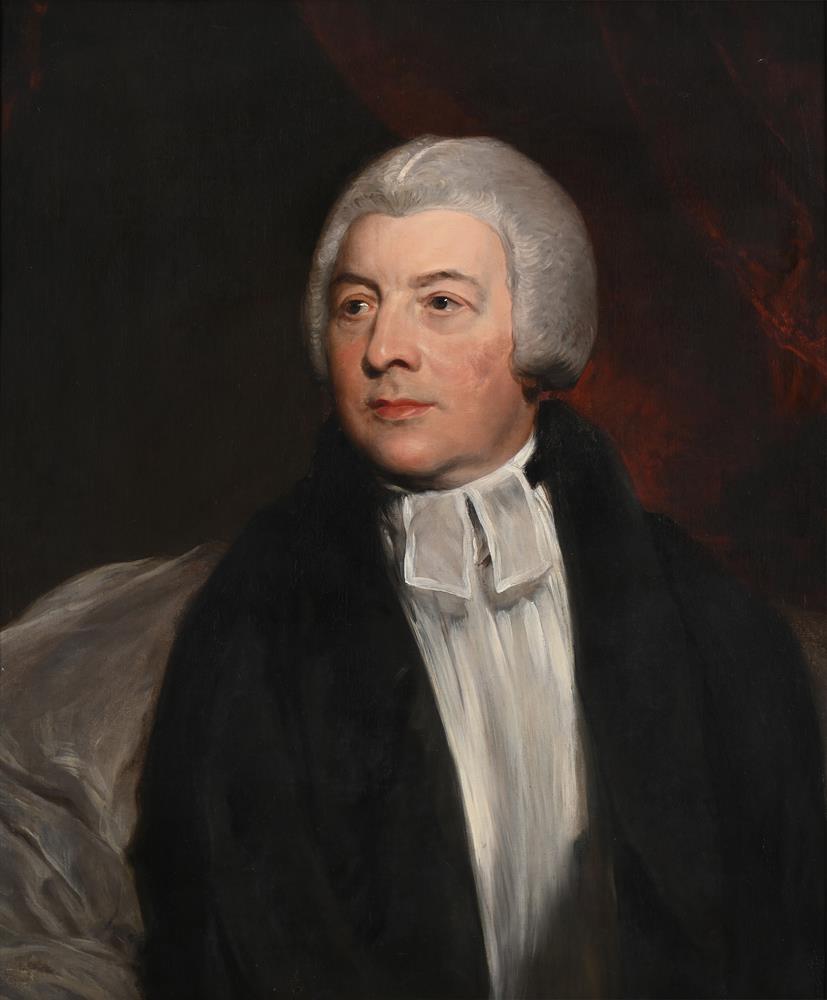SIR THOMAS LAWRENCE (BRITISH 1769-1830) PORTRAIT OF THE RT. HON. SYLVESTER DOUGLAS, LATER BARON GLENBERVIE OF KINCARDINE Oil on canvas 129 x 103.5cm (50¾ x 40½ in.) Provenance: The collection of Lord Glenbervie Inherited by The Hon. Frederick Sylvester North Douglas Thence by descent at Weston Hall. Exhibited: London, Royal Academy, 1792, no.183. London, Royal Academy, Lawrence Exhibition, 1961-62, no. 59 Literature: D.E. Williams, The Life and Correspondence of Sir Thomas Lawrence London, 1831, volume 1, p. 128 R.S. Gower, Sir Thomas Lawrence London, Paris, New York, 1900, p. 124 W. Armstrong, Lawrence, London, 1913, p. 127 K. Garlick, 'A catalogue of the paintings, drawings and pastels of Sir Thomas Lawrence', Walpole Society, XXXIX, Glasgow, 1964, p. 89 F. Bamford, 'Weston Hall, Northamptonshire - I: The Home of Sir Sacheverell and Lady Sitwell', Country Life, 22 January 1976, p. 178, fig. 10 K. Garlick, Sir Thomas Lawrence - A Complete Catalogue of the Oil Paintings, Oxford, 1989, p. 180, no. 252, pl. 15 Catalogue Note: This sensitive portrait of Sylvester Douglas (1743-1823), politician and diarist, and in 1800, Baron Glenbervie of Kincardine, was painted by Sir Thomas Lawrence in circa 1792, and the same year exhibited at the Royal Academy. Douglas is shown in a professional capacity as a barrister and King's Counsel; his most recent case brief lies on the table, loosely bound in its traditional red ribbon. The painting portrays him as a man of integrity and intelligence, dedicated to his profession. In its confident and painterly manner, it shows Lawrence to be the natural successor to Gainsborough and Reynolds. Douglas was born in Fechil, Aberdeenshire, the elder and only surviving son of John Douglas a landowner of Whiteriggs, Kincardineshire and his first wife, Margaret Gordon, daughter and co-heir of James Gordon of Fechil. In 1766, Douglas took a medical degree at Leiden. After further travelling in Europe, to Paris, Italy, Vienna and Hungary, he returned to London in 1769, and switched from medicine to law, entering Lincoln's Inn in 1771. His political ambitions were evident from an early stage for prior to being called to the bar in 1776, he had already published reports on the disputed parliamentary elections to the 1774 House of Commons. From 1778 he reported Lord Mansfield's judicial decisions in King's Bench, published in 1783. He was elected FSA in 1781 and FRS 1795. Douglas's progression was undoubtedly assisted by his marriage in 1789 to Catherine Anne North (1760-1817), eldest daughter of Frederick North, 2nd Earl of Guilford (1732-92) and Prime Minister from 1770-82. Lord North was renowned for his pacifying approach to the conflict in the colonies, arguing to George III that victory for Britain would be financially disastrous, an important factor in the success of the American War of Independence. Douglas joined the treasury board; in this role he promoted the Irish union, most notably in his speech of 22 April 1799, published in 1800. In January 1800, Douglas was appointed governor to the Cape, and on 30 November the same year he was created Lord Glenbervie of Kincardine in the Irish peerage. In the event he would not take up his position and for the next fifteen years, he was an active member of both the English and Irish parliaments, which he vividly documented in his diaries. These, together with his journals, published piecemeal in 1910 and 1928, are a record of his aspirations and disappointments, interlaced with scandalous anecdotes, political gossip, and travel notes. After the death of his wife in 1817 and his son in 1819, Lord Glenbervie turned to literary pursuits, publishing his translation of an excerpt from the Italian poet Fortiguerri's Ricciardetto in 1822. He died the following year at Cheltenham on 2 May, 1823, whereupon his title became extinct.
SIR THOMAS LAWRENCE (BRITISH 1769-1830) PORTRAIT OF THE RT. HON. SYLVESTER DOUGLAS, LATER BARON GLENBERVIE OF KINCARDINE Oil on canvas 129 x 103.5cm (50¾ x 40½ in.) Provenance: The collection of Lord Glenbervie Inherited by The Hon. Frederick Sylvester North Douglas Thence by descent at Weston Hall. Exhibited: London, Royal Academy, 1792, no.183. London, Royal Academy, Lawrence Exhibition, 1961-62, no. 59 Literature: D.E. Williams, The Life and Correspondence of Sir Thomas Lawrence London, 1831, volume 1, p. 128 R.S. Gower, Sir Thomas Lawrence London, Paris, New York, 1900, p. 124 W. Armstrong, Lawrence, London, 1913, p. 127 K. Garlick, 'A catalogue of the paintings, drawings and pastels of Sir Thomas Lawrence', Walpole Society, XXXIX, Glasgow, 1964, p. 89 F. Bamford, 'Weston Hall, Northamptonshire - I: The Home of Sir Sacheverell and Lady Sitwell', Country Life, 22 January 1976, p. 178, fig. 10 K. Garlick, Sir Thomas Lawrence - A Complete Catalogue of the Oil Paintings, Oxford, 1989, p. 180, no. 252, pl. 15 Catalogue Note: This sensitive portrait of Sylvester Douglas (1743-1823), politician and diarist, and in 1800, Baron Glenbervie of Kincardine, was painted by Sir Thomas Lawrence in circa 1792, and the same year exhibited at the Royal Academy. Douglas is shown in a professional capacity as a barrister and King's Counsel; his most recent case brief lies on the table, loosely bound in its traditional red ribbon. The painting portrays him as a man of integrity and intelligence, dedicated to his profession. In its confident and painterly manner, it shows Lawrence to be the natural successor to Gainsborough and Reynolds. Douglas was born in Fechil, Aberdeenshire, the elder and only surviving son of John Douglas a landowner of Whiteriggs, Kincardineshire and his first wife, Margaret Gordon, daughter and co-heir of James Gordon of Fechil. In 1766, Douglas took a medical degree at Leiden. After further travelling in Europe, to Paris, Italy, Vienna and Hungary, he returned to London in 1769, and switched from medicine to law, entering Lincoln's Inn in 1771. His political ambitions were evident from an early stage for prior to being called to the bar in 1776, he had already published reports on the disputed parliamentary elections to the 1774 House of Commons. From 1778 he reported Lord Mansfield's judicial decisions in King's Bench, published in 1783. He was elected FSA in 1781 and FRS 1795. Douglas's progression was undoubtedly assisted by his marriage in 1789 to Catherine Anne North (1760-1817), eldest daughter of Frederick North, 2nd Earl of Guilford (1732-92) and Prime Minister from 1770-82. Lord North was renowned for his pacifying approach to the conflict in the colonies, arguing to George III that victory for Britain would be financially disastrous, an important factor in the success of the American War of Independence. Douglas joined the treasury board; in this role he promoted the Irish union, most notably in his speech of 22 April 1799, published in 1800. In January 1800, Douglas was appointed governor to the Cape, and on 30 November the same year he was created Lord Glenbervie of Kincardine in the Irish peerage. In the event he would not take up his position and for the next fifteen years, he was an active member of both the English and Irish parliaments, which he vividly documented in his diaries. These, together with his journals, published piecemeal in 1910 and 1928, are a record of his aspirations and disappointments, interlaced with scandalous anecdotes, political gossip, and travel notes. After the death of his wife in 1817 and his son in 1819, Lord Glenbervie turned to literary pursuits, publishing his translation of an excerpt from the Italian poet Fortiguerri's Ricciardetto in 1822. He died the following year at Cheltenham on 2 May, 1823, whereupon his title became extinct.















Try LotSearch and its premium features for 7 days - without any costs!
Be notified automatically about new items in upcoming auctions.
Create an alert